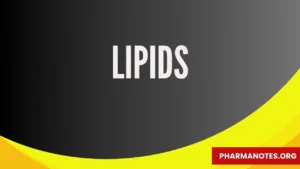Lipids

Lipids
Lipids are chemically defined as a substance that changed in soluble in water and soluble in organic compound like chloroform, ether, benzene, etc.
Lipids are the main constituents of plant and Animal cells.
Leopard is a type of organic molecules found in a living thing. It is oily or waxy.
Biological function of Lipids.
Building block for membrane phospholipid are present in almost all membranes.
Installment of organs of cell.
Carries for fat Soluble Vitamins.
As energy source lipids provide 9kcl of energy per gram.
Provide shop absorption & insulation.
Dietary fibre act as carrier of Lipids Soluble Vitamins into cells of small intestine.
Biological importance of Lipids:-
• Important dietary compounds and storage form of energy.
• Structure components of biomembrane.
• Providing insulation against changes in external temperature.
• Giving shape and outline to the body.
• Protecting internal organs by providing a cushioning effect.
• Provide shock absorption and insulation.
Classification of Lipids:-
1. Simple Lipids
a) Fats
b) Waxes
2. Compound Lipids
3. Derived Lipids
Fatty acid:-
• It consists of long chain of hydro-carbon having carboxyl group at one end and methyl group at another end.
• Fatty acids very in chain length and degree of unsaturation.
It is classified into two classes.
1. a) Saturated fatty acids
2. b) Unsaturated fatty acids
a) Saturated fatty acids:-
• These acids does not contain any double band called saturated fatty acids.
• e.g. : Palmitic acid, Stearic Acid
b) Unsaturated fatty acids:-
• Fatty acid which have one or more double bond in their molecules are called unsaturated fatty acid.
• eg. :- polmitoliec acid, Arachidonic acid.
Essential Fatty acids:-
• The fatty acids which cannot be synthesized in the body are etermed as essential fatty acids.
• These are essential for complete nutrition of animals and therefore should be supplied through diet.
• These are polyunsaturated fatty acids are linoleic acid.
A. Simple Lipids
• Simple Lipids are a fatty acid ester of different alcohols and carries no other substances.
a) Oil and Fats:-
• These Lipids are esters of fatty acid and alcohol with glycerol (Glycerin).
• At room temperature fats are solid because largely they are made up of unsaturation fatty acids.
• While oil contain one or more unsaturated fatty acids due to which oils are liquid at room temperature.
b) Waxes:-
• Waxes are esters of fatty acids with higher monohydric alcohol.
• eg. Bee’s waxes, Vitamin A ester, Vitamin D ester, cholesterol ester.
B. Compound Lipids
• Ester of fatty acids + Alcohol + Other group like phosphate, Nitrogenous base, Carbohydrate Protein etc.
1) Phospholipids:-
• The term phospholipid is used to describe any lipid can containing phosphorus.
• Phospholipid contain phosphoric acid, fatty acids, alcohol and generally a Nitrogenous base.
2) Glycolipids:-
• Combination of Carbohydrates and Lipids are Glycolipids.
• Basically they are amphipathic carbohydrate glyceride derivative but do not contain phosphate. E.g:- Cerebroids, Gangliosides.
3) Lipo-proteins:-
• Biomolecules containing Lipids are Proteins found in mitochondria endoplasmic reticle and nucleic.
D) Lipo-polysaccharides:-
• These are found in gram-negative micro-organisms which are giant macro-polymers very complex in structure when these are released to blood stream produce untoward reactions and are toxic.
• They are also known as endotoxins.
• Pyrogens are Lipo-polysaccharides.
C. Derived Lipids
• This class of Lipids consists of fatty acids, steroids, fat soluble vitamin like – Vitamin A, Vitamin D, eicosanoids like prostaglandin ketone bodies glycerol and other alcohols.
• Steroids:- Steroids are Lipids because they are hydrophobic and insoluble in water.
• Cholesterol is the most common steroid and is the precursor of Vitamin D, Testosterone, Estrogen progesterone etc.
• The example of steroids found in biologicals system are cholesterol, Bio-acids, Vitamin-D, Sex Hormone etc.
• Note:- Cholesterol is an important steroid found in animal tissue especially in brain and spinal cord. It is major component of plasma membrane and plasma Lipo-proteins.
Qualitative tests for Lipids:-
1) Solubility:-
• Solubility of Lipid in organic solvents depends on length of hydro-carbon chain of the fatty acids attached to glyceride.
• Lipids are soluble in solvents like- Chloroform, ether, alcohol, hexane etc.
2) Formation of a translucent spot on paper:-
• Ordinary writing paper becomes semi-transparent when a drop of oil is applied to paper.
3) Emulsification:-
• When oil or liquid fat is shaken with water. It is finely divided and is displayed in the water
to form what is known as emulsion.
• Shake a drop of oil with little water in a test tube. The oil becomes finally divided forming an emulsion.
4) Iodine absorption test:-
• This test is for unsaturated fatty acids for fat. A drop of iodine is added to fat (Fat some is prepared in chloroform) and shaken.
• This solution will decolorizes if unsaturated fatty acid is present.
Disease related to fat metabolism:-
Excessive excretion of fat in the faces is known as steatorrhea but it is either maldigesting of fats due to inadequate secretion of pancreatic lipase or bile salts or even may be defective absorption due to intestinal disease like – coeliac disease.
Obesity:-
1. Obesity is another disorder which is due to accumulation of excess of body fat.
Lipodosis:-
1. This denotes the abnormal Lipo-proteins in blood or specific Lipids in tissues
Symptoms:-
1. Enlarge liver spleen
2. Abdomen swell
3. Tiredness pain
4. Bone broke
Hyperlipidemia:-
1. It is a condition in which plasma cholesterol or plasma triglyceride level is increased. This condition occurs due to inherent genetic defect
Symptoms:-
1. Chest pain
2. Heart attack
3. Sores on the toes.
Hyperlipoproteinemia:-
• An oilment in which cholesterol or triglycerides containing Lipo-proteins are reported in high concentration in the blood.
Symptoms:-
1. Enlarge liver spleen
2. Heart disease.
